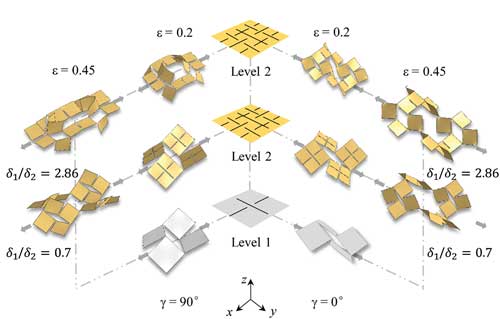| Dec 12, 2019 | |
Morphable metamaterials made with hierarchical kirigami |
|
| (Nanowerk Spotlight) Researchers have identified kirigami as an intriguing tool to create programmable mechanical metamaterials with unconventional mechanical and morphological responses. These reconfigurable metamaterials offer a new material platform to achieve dramatic changes of mechanical and optical properties, which are arising from dynamically tunable geometrical structures. | |
| Metamaterials are a class of artificially engineered composite materials that derive their properties from internal microstructure, rather than chemical composition. | |
| Kirigami, the ancient Japanese art of cutting and folding paper to obtain complex 3D shapes, can be applied to transform two-dimensional sheets of materials into complex three-dimensional shapes with a broader choice of geometries than classical origami. | |
| "A key feature of kirigami metamaterials is that they are conveniently cut when flat and then exploit local elastic instabilities to transform into complex 3D configurations upon stretching," Katia Bertoldi, the William and Ami Kuan Danoff Professor of Applied Mechanics at Harvard John A. Paulson School of Engineering & Applied Sciences, explains to Nanowerk. "Interestingly, the introduction of hierarchical cuts into flat kirigami sheets further enriches the mechanical response of the system as it enables higher stretchability, wider tunability of the bandgaps, and larger negative Poisson's ratios." | |
| In recent work, published in Advanced Functional Materials ("Programmable Hierarchical Kirigami"), Bertoldi and her team demonstrate how structural hierarchy can be exploited to realize thin kirigami metamaterials with highly nonlinear mechanical responses and complex deformation-induced 3D pattern transformations. | |
| More specifically, they found that by carefully choosing the thickness of the sheets and the width of the hinges associated with each hierarchical level, the stress–strain response of the surface can be effectively programmed and a variety of different buckling-induced 3D deformation patterns be triggered. | |
| Moreover, the team's results indicate that by combining different hierarchical patterns together, not only can the range of achievable mechanical responses be further expanded, but also information can be encrypted into the structure. | |
 |
|
| Numerical snapshots of kirigami sheets at different levels of applied deformation. δ is the width of hinges of the cuts and ε the level of applied strain. (Reprinted with permission from Wiley-VCH Verlag) (click on image to enlarge) | |
| This means that a heterogeneous surface – which, before being stretched seems like a plain homogeneous sheet – is capable of revealing information in form of an encrypted image as soon as the system is subjected to uniaxial stretching to induce out-of-plane buckling. | |
| In fabricating their programmable kirigami, the researchers first use a combination of experiments and numerical simulations to study the response under uniaxial tension of kirigami sheets with hierarchical cuts arranged to form an array of squares connected at their vertices via thin ligaments. They investigate in detail both the effect of geometry as well as plasticity of the sheets. | |
| "We found that for sufficiently small thicknesses, the behavior is completely different from that previously reported for thick sheets, as mechanical instabilities triggered by the applied deformation result in the formation of complex 3D patterns and sequential pop-up processes," Bertoldi points out. | |
| The team then shows that the geometric parameters of the embedded hierarchy enable them to tune both the morphology of the buckling-induced 3D patterns as well as the stress–strain response of the surfaces. | |
| Finally, they demonstrate that by creating heterogeneous hierarchical kirigami surfaces, they can expand the range of attainable mechanical responses and encrypt information in the form of an image that can then be read out upon stretching (as demonstrated in the video below). | |
| The researchers note that the response of the surface texture of their kirigami metamaterial is not always fully reversible due to the deformation of the used plastic material. Since this design concept can be easily extended to different materials, they may now look for an alternative elastic/hyperelastic material to fabricate more fully reversible surface textures. | |
| "Our results indicate that hierarchical cuts can be exploited to realize displays and encryption based on kirigami principles," Bertoldi concludes. "We envision hierarchical kirigami surfaces to be integrated into soft robotic materials to create tactile sensors, smart displays, or friction-controlled skins that facilitate the interaction with the surrounding environment." | |
 By
Michael
Berger
– Michael is author of three books by the Royal Society of Chemistry:
Nano-Society: Pushing the Boundaries of Technology,
Nanotechnology: The Future is Tiny, and
Nanoengineering: The Skills and Tools Making Technology Invisible
Copyright ©
Nanowerk LLC
By
Michael
Berger
– Michael is author of three books by the Royal Society of Chemistry:
Nano-Society: Pushing the Boundaries of Technology,
Nanotechnology: The Future is Tiny, and
Nanoengineering: The Skills and Tools Making Technology Invisible
Copyright ©
Nanowerk LLC
|
|
|
Become a Spotlight guest author! Join our large and growing group of guest contributors. Have you just published a scientific paper or have other exciting developments to share with the nanotechnology community? Here is how to publish on nanowerk.com. |
|
